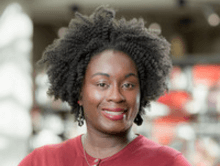Last Updated on July 9, 2022, 9:43 am ET

the interviewee
For Fair Use Week 2022, the Association of Research Libraries (ARL) teamed up with the Social Science Research Council (SSRC) #MediaWell project and asked experts to weigh in on how fair use supports research, news, and truth. Sandra Enimil, copyright librarian and contracting specialist at Yale University Library and chair of the Association of College and Research Libraries (ACRL) Research and Scholarly Environment Committee, shares below how fair use helps information reach intended audiences.
Note: This post was transcribed from a conversation and lightly edited.
When you look at the actual statute about fair use, Section 107 of the Copyright Act, it calls out news reporting by name. It states that it would not be an infringement of copyright to reuse some content in the course of news reporting—it’s specifically called out. So, I think that our legislative branch recognized that people who are in the business of reporting need to be able to use content, sometimes in ways that it was intended to be used, and sometimes in ways that it was not intended to be used, in order to tell stories. Reporters need to be able to tell stories in a way that provides information, in a way that might meet their audience where they are, or have an impact, or be accessible to an audience.
I think of specific examples of how information is translated or presented to children—the ways in which people take information and make it into cartoons, or use cartoons or use elements of song, and bring in ways that they can communicate more effectively to provide information to folks. Without fair use, that’s not possible. Yes, you could possibly create those things yourself. But being able to tie in things that someone might recognize—that you didn’t create or you couldn’t create—has the benefit of your audience being able to access the information easily. I think taking the creativity into account is critical—because there is a lot of creativity that comes into using content, not just in the creation of it, but using it to tell a particular story.
I was in a conversation recently about fair use around the world, and I’m just really happy to be in the United States because we have a statute that is very broad, but very clearly articulates examples of what it covers. It can also cover things that are not specifically mentioned in the law. I’m happy that I’m here, operating in this system, being able to take advantage of fair use, and seeing how people are using their creativity to exercise fair use, especially in news reporting, especially to convey information. These days, when trying to convey information to people, you have to get more and more creative. You have to find ways to quickly grab someone’s attention and share information. Fair use provides an incredible way to do that.



